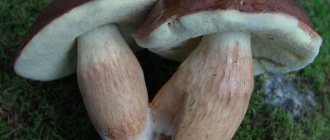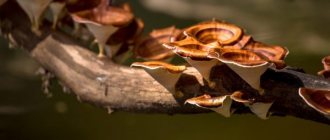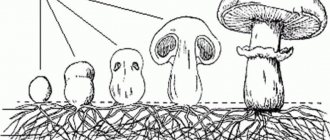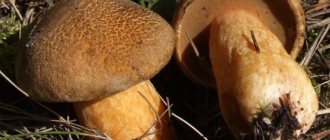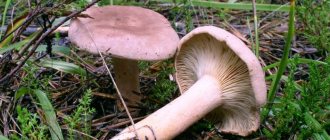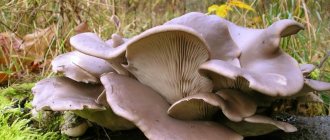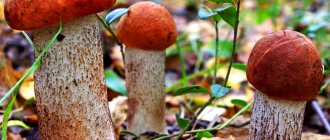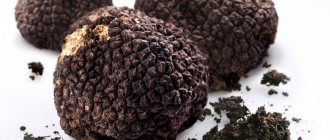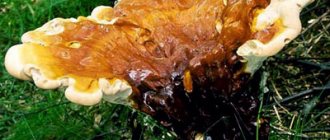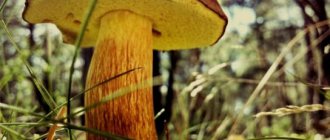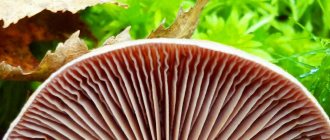The identification of mushrooms as boletus species and the delineation of this genus from the Boletus species is unclear and controversial. Moss fly mushrooms represent a heterogeneous mixture of several groups and species. These groups are separated from each other by different anatomical and some other features. Also, recent research by mycologists shows that flywheels do not descend from one common fungal ancestor.
Etymology of the name "moss fly"
The fruiting bodies of this species occupy moss-covered clearings in coniferous and mixed plantings. Mushroom pickers collect moss mushrooms from late spring until the first frost. Almost all mushrooms of this species are edible, the only exception being false fly mushrooms.
Fly mushrooms: description, types
This type of mushroom belongs to the well-known genus Boletaceae. Adult specimens reach more than 20 cm in diameter. Depending on the type, the flesh acquires a yellow, reddish, or bluish tint. Like all mushrooms, the hymenophore is located in the lower part. The hymenium of the moss fly is tubular. The pores are much wider than those of other types of forest mushrooms.
Types of flywheels:
- green;
- yellow-brown;
- red;
- brown (Polish);
- fissured.
Boletus mushrooms are a relative of the boletus mushroom.
Edible flywheels differ from false ones by the presence of a bluish color, which is released when pressure is applied to the hymenophore. The stem of the mushroom is covered with wrinkles. It reaches 8 cm in length. Spore powder can be of different colors.
Fractured flywheel
It grows in deciduous and coniferous forests. You can meet it from July to October. Compared to other species, the fissured flywheel has a thick and fleshy cap. It is matte on top and abundantly covered with cracks of various sizes. The cap grows up to 10 cm in diameter.
In adult specimens, the pulp has a slimy consistency, which is not very suitable for preparing salads.
The flesh is red, less often white. The stem of the mushroom has a cylindrical shape. It is distinguished by its yellowish skin, which is reddish near the base. In an adult specimen, it can reach 6 cm in length and about 2 cm in diameter.
The fissured flywheel mushroom is distinguished by the color of its pulp when pressed. Initially it turns blue, but after a few minutes the area turns red.
This type is suitable for pickling, canning, and frying. Also, cracked flywheel is dried and added to salads.
Beneficial features
Mushrooms contain a lot of vitamins
Moss mushrooms have a large number of amino acids in their composition. Other substances also benefit the body:
- vitamins A, PP, D;
- various essential oils;
- enzymes;
- calcium;
- chitin;
- molybdenum.
With regular consumption of mushrooms, positive changes in the body are noted.
- The course of inflammatory processes is slowed down due to the high content of natural antibiotics in the pulp.
- In the absence of gastrointestinal diseases, its functioning improves due to the presence of essential oils and specific enzymes.
- If you replace meat with these mushrooms in your daily menu, you will experience a gradual decrease in body weight. The calorie content is small - about 19 kcal per 100 g fresh and about 60 kcal per 100 g - in fried and pickled mushrooms.
- Vision gradually improves and the manifestation of eye diseases decreases.
- The functioning of the nervous system is normalized, the person becomes less susceptible to stress. Efficiency increases.
- The likelihood of atherosclerosis is reduced. The speed of thinking and analysis of the situation accelerates.
- Toxins are gradually removed thanks to chitin.
- The condition of hair, skin and nails improves.
Contraindications
- Chronic diseases of the stomach, liver, kidneys;
- Allergy;
- Child's age up to 3 years;
- The harvest was collected in environmentally polluted places.
Experts advise pregnant, lactating, elderly and children under 10 years of age to refrain from consuming fly mushrooms, although this is not prohibited.
Description of the appearance of the brown flywheel
The brown type of fly mushroom is often called the Polish mushroom. It has a brown cap that takes the shape of a pillow. It reaches 20 cm in diameter. The lower part of the cap is whitish. When pressed, a bluish or brownish spot appears.
The leg is cylindrical, thick. It grows up to 14 cm in length and 4 cm in diameter. When pressed, it also changes its color to blue. The pulp is quite dense. In fresh mushrooms it has a pleasant fruity or mushroom aroma.
Polish mushrooms are the most popular. They are also dried, fried, pickled, and frozen. Brown moss mushrooms are also used raw.
They collect mushrooms in coniferous forests, less often in mixed forests. They grow from July to November. It all depends on the region.
Features of the red flywheel
An equally popular species, which is easily recognized by its rich red cap. He prefers deciduous foxes, or rather areas covered with moss and grass.
Since the red mushroom darkens quickly, it is recommended to cook it immediately after cutting.
The hat is small. In an adult mushroom it does not exceed 8 cm in diameter. The hemenophore is yellowish in color and turns blue with the slightest pressure. The leg has a cylindrical shape. Its height reaches 10 cm. It grows about 1 cm in diameter. The main part is yellow, but closer to the base it becomes red-pink.
As for the pulp, it is quite dense with a yellowish tint. Such moss mushrooms grow from August to September. When raw, it exudes a pleasant aroma, which disappears during cooking.
Compared to other species, red flywheel is not recommended to be dried or frozen. This is due to the fact that the pulp quickly darkens and the products lose their presentation. Such mushrooms are salted, canned and fried.
Benefits and harms
The composition of moss mushrooms is distinguished by many useful substances:
- Vitamin A, C, D, PP;
- B vitamins;
- Minerals (zinc, calcium, phosphorus, potassium, copper, molybdenum);
- Enzymes: lipases, amylases, proteinases and oxidoreductases;
- Amino acids;
- Essential oils;
- Proteins, carbohydrates, etc.
The flywheel contains more amino acids than other mushrooms. Due to its minimal calorie content (only 19 kcal per 100g), it, like other mushrooms, is recommended for dietary use. Moss mushrooms contain natural antibacterial components and help in the fight against infectious diseases and colds, strengthen the protective functions of the body's immune system, and help improve blood composition.
Eating flywheel does not cause harm to the human body. However, like other mushrooms, they are difficult to digest food for the stomach. For this reason, it is not recommended to consume their moss mushroom in large quantities for chronic diseases of the digestive system or liver.
Interesting! Moss mushrooms are less likely to cause digestive difficulties compared to other mushrooms.
Eating dishes made from fly mushrooms is not recommended:
- children under three years old;
- if you are allergic to mushrooms.
Also, you should not collect these mushrooms near highways and factories, due to their ability to accumulate heavy metals and harmful substances.
Distinctive features of the yellow-brown flywheel
Scientists who have studied yellow-brown moss fly mushrooms claim that this species should be classified as a member of the Maslyat genus. This is due to the fact that the structure of the mushroom is very similar to an oil can, although outwardly it does not resemble it at all.
The hat has a brownish-yellow tint, the edges are folded. Its size is about 144 mm. In adult specimens, it changes its color to light ocher. The skin is very difficult to separate from the pulp. When pressed, a deep blue stain remains.
The stem of this mushroom is long and cylindrical. It grows up to 90 cm tall. The thickness of the stem is about 3.5 cm, lemon-colored. As for the pulp, the yellow-brown flywheel is dense and quite hard. Mushrooms are collected from July to October.
Video gallery
Video reviews
A selection of videos with descriptions and recipes for preparing mushrooms
Mushroom experts of the Russian Federation TV, Mushrooms of Ukraine / Mushrooms of Ukraine, My garden, vegetable garden and more!
Green moss
The most recognizable type of mushroom. This moss fly is distinguished by a rich brown cap, which can exceed 10 cm in diameter. The leg of this species is also cylindrical and green in color. Closer to the base it expands. The mushroom grows up to 9 cm in height. The thickness of the stem does not exceed 3 cm.
The green type of flywheel is not suitable for drying, since the workpieces can darken during long-term storage.
The flesh of the green flywheel is dense and elastic, which mushroom pickers really like. When cut, it changes its hue to blue. Green moss mushroom grows near roads and in fields. You can also see it in the forests. Mushrooms appear from the second part of May until the end of October.
How to distinguish dangerous mushrooms from edible ones
In forests, flyfly parasites are very common. Although they do not belong to the group of poisonous mushrooms, they can still spoil the dish.
Doubles taste bad. In raw and dried form, they contain bitterness, which does not always disappear even with heat treatment.
Moss fly twins:
- Chestnut. The cap is brownish-red. The pulp is snow-white and does not change color. It is this mushroom that is often confused with the Polish mushroom.
- Gall. This moss fly grows from June to October. The cap is slightly wavy at the edges. It contains a pink liquid, which gives it a bitter taste. The gall fungus is never damaged by insects.
- Peppery. The hat is light brown, convex. The pulp is light with a yellowish tint. When cut, this mushroom changes its color to red.
Knowing all the features of moss mushrooms, you can provide your entire family with healthy and tasty preparations. The main thing is not to confuse false and edible specimens, otherwise the dishes will be spoiled.
Cooking recipes
Moss fly salad
After a “quiet hunt,” a novice mushroom picker has a problem: how to cook moss mushrooms appetizingly, despite their mediocre taste declared in all culinary reference books?
The main thing is to remember an important thing - flywheels immediately begin to darken from interaction with air, so fresh peeled mushrooms are immediately immersed in water, adding 2 g of citric acid and a teaspoon of salt per 1 liter. When pickled and pickled, mushrooms are excellent preparations for the winter, but they are extremely rarely used for drying - due to the same characteristic darkening
To prepare dishes from moss mushrooms, both caps and legs are used. Moss mushrooms do not need to be pre-boiled before frying or adding to soups, and the Polish mushroom is also eaten raw as the main accent of salads. The “Awesome” salad is incredibly tasty, although the moss mushrooms used for it are still pickled
When pickled and pickled, mushrooms are excellent preparations for the winter, but they are extremely rarely used for drying - due to the same characteristic darkening. To prepare dishes from moss mushrooms, both caps and legs are used. Moss mushrooms do not need to be pre-boiled before frying or adding to soups, and the Polish mushroom is also eaten raw as the main accent of salads. The “Awesome” salad is incredibly tasty, although the moss mushrooms used for it are still pickled.
Salad with Polish mushroom
Main ingredients:
- mushrooms – 0.5 l jar,
- processed cheese – 100 g,
- boiled potatoes – 5–6 pieces,
- pickled cucumber – 2-3 pieces,
- mayonnaise for dressing,
- greens to taste.
Experienced cooks recommend using cucumbers for this salad from a marinade with citric acid rather than vinegar. All components of the dish are crushed, mixed and seasoned with mayonnaise, and greens are added at your discretion.
Moss mushrooms for this salad, and for many other dishes, are prepared for the winter as follows:
Marinated moss mushrooms
Mushrooms are cleaned and thoroughly washed, damaged ones and those that are too large are sorted out, leaving caps no more than 5–6 cm in circumference.
Place in a saucepan, add water and bring to a boil, then boil for 10–15 minutes over low heat and drain the contents into a colander. Allow the water to drain while preparing the marinade. Add 1 tablespoon of salt and sugar to 1 liter of water, add 2 small bay leaves, a few cloves of garlic and just a little cloves. After boiling, pour 1 tbsp. a spoonful of vinegar and transfer the mushrooms to the pan. Boil in the marinade for 5 minutes, then place in sterilized glass containers so that the liquid covers the entire contents, and roll up.
Moss mushrooms make delicious soups, stewed or fried side dishes, and baked in sour cream they can easily claim to be an exquisite culinary masterpiece.
